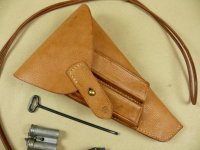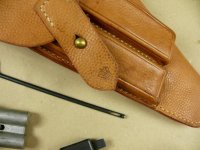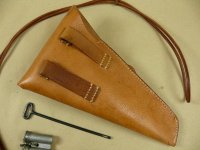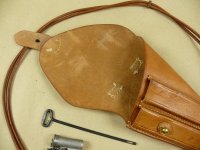Having recently acquired a Swedish M40 Lahti pistol, I thought I'd draft an article on the Lahtis. This is just a draft, and I'd welcome any comments and/or corrections. "Qball", since you are in Sweden, I'd particularly appreciate any input you might offer. At any rate, here goes.
John

The series of L35 and M40 Lahti pistols produced in Finland and Sweden shortly before and during the World War II period are some of the most historical and fascinating military arms of that era. These pistols were specifically designed to be robust and operate reliably in harsh northern winters, and in that mission they performed admirably. Not often seen today in the western world, they are at first glance often mistaken for German P.08 “Lugers,” but they’re in fact quite different. Guns of this type first saw action in the Russo-Finnish War of 1939-40, and while most production had ceased by 1950, they were still in active military service well into the 1980s.
The first pistol of the type was designed and developed in 1929 by Aimo Lahti, a well-known Finnish arms designer. At the request of his superiors, he set out to craft a pistol that could cope with the severe Scandinavian winters better than the standard Lugers then in use. After some continuing improvements, the resulting 9x19mm firearm was adopted by Finland in 1935 and became known as the L35. In neighboring Sweden, that country was also seeking a new handgun to replace its aging M1907 Browning pistols. These were chambered in 9x20mm (SR Browning Long), very similar in power to the current .380 ACP cartridge. The German Walther 9x19mm HP (later P.38) pistol was chosen as the M39. Some were purchased, but with the outbreak of World War II, non-availability of German-made guns and then licensing and production problems on the M39 proved insurmountable for war-neutral Sweden. Seeing the efficient performance of the Finnish Lahti L35 in the Winter War, Sweden decided it would produce a slightly modified version of this outstanding pistol. The Swedes began to produce it in 1942 as the M40. The Finns had their pistols made at the Valtion Kivaaritehdas (State Weapons Factory) in Jyvaskyla. Sweden had theirs produced at Husqvarna Vapenfabriks AB. Both pistols are generically referred to today as Lahtis.
The first Finnish pistols were virtually hand built, and sporadic production was twice halted by conflict with the Russians in 1939-1940 and 1944-1946. When production stopped around 1950, only about 12,000 total L35s had been made. Another 1,250 were ordered in 1958, but since much of the Finnish tooling was then gone, Husqvarna had to step in and produce a hybrid L35/M40 model. In Sweden, Husqvarna was the only manufacturer, and produced over 80,000 M40s and about 1,000 civilian counterparts of the arm between 1942 and 1946. Although the Finns had made some prototypes in 7.65mm Parabellum, all production guns from both counties were made in 9x19mm (9mm Parabellum). The gun illustrated is a Husqvarna-made example, produced in 1945. It shows an “S.S.” inspection mark at the rear, used by Captain Sten Stenmo. In Sweden, because Husqvarna also made iron kitchen ranges and because the M40 was substantial and heavy, it was often called by its nickname, the “iron stove.”
The fact that these pistols resemble the Luger came about naturally, given that the 7.65mm Parabellum pistol was the L35’s predecessor in Finland. Initial field stripping is almost identical to the Luger, where the barrel/receiver assembly is pushed back, and a takedown latch located in the left forefront of the lower receiver is rotated down to release the upper assembly by drawing it forward. However, the Lahti uses an entirely different locking mechanism. The barrel is attached to a box-like extension that encloses most of the action. In this extension, the square cross-section bolt is housed. The bolt has two grooved projections at the rear which are used to retract it manually. On top of the bolt there is a separate moveable locking yoke in the form of an inverted “U”. This fits into grooves in both the bolt and the barrel extension. An internal hammer strikes the firing pin within the bolt. When the gun is fired, the barrel/extension/bolt assembly recoils together about 6 mm. Then the locking yoke is cammed upwards, allowing the bolt to continue to the rear by itself. A unique feature of the Lahti pistols is an ingenious rocking “accelerator” which gives the bolt an additional kick to the rear. This helps cycling when ammo pressure is reduced by extremely cold temperatures. A coiled return spring in the upper part of the bolt returns it to load another round from the magazine. A hold-open device keeps the bolt back on firing the last round. The magazine must be removed or dropped a short distance to allow the bolt to go forward after brief manual retraction. A rotating manual safety is used, placed in a position close to that employed on the Luger. A large ejection port on the right side helps to assure positive ejection of the empty shell. An eight-round magazine is utilized with a very strong internal spring, virtually necessitating the use of a loading tool which is provided in every military holster. The issue flap holsters also contain two extra magazines and a cleaning rod. Although both the L35 and M40 have the grip frames configured for the attachment of a wood and leather shoulder stock, very few of these were made and used, mostly in Finland.
The Finnish and Swedish Lahtis differ in only a few particulars. The Finnish models have a loaded chamber indicator above the barrel/frame junction. Initially, so did the Swedish versions, but these were soon ground off and filled in. Most of the M40s did not have this indicator. The Swedish pistols have a larger trigger guard, soon added after initial production to allow better manipulation with gloved hands. Not long after production started, the M40 was graced with a barrel shoulder that looked like a hex nut. This enabled easier barrel replacement. Early barrels had a ramped front sight base, while most production guns utilized a more upright rectangular base. The fixed sights on these guns are satisfyingly large and visible. The Swedish guns had different metallurgy employed than their Finnish cousins. During the war, there was a shortage of the correct grade of steel made with nickel. Therefore only the barrels were made with the short-supply alloy. The bolt and frames were made from a different grade of steel. In extensive use with powerful submachine ammo (104 grain bullet at 1346 fps), sometimes the bolts cracked. A large number of M40s had their accelerators removed to help prevent this from occurring. Many M1907 pistols were then re-issued. In 1993, Sweden officially retired the M40 and adopted the 9x19mm Glock 17 pistol as the M88. Almost all (about 50,000) of the existing military M40 pistols were ordered to be melted down, much to the dismay of collectors today.
Although Sweden remained neutral during WWII, it unofficially trained refugees from Norway and Denmark, and sold about 10,000 M40 pistols to Denmark for police use after the war. Some unmarked “sterile” M40s exist which were destined for clandestine work with the Swedish military Secret Service. Thousands of Swedish volunteers went to help neighboring Finland in its battles against the Russians, and of course often took their Swedish Lahtis along.
M40 pistols are still popular in Swedish marksmanship events today, and many of these guns are still used by the civil Swedish Pistol Association. A special competition category using M40, L35, M1907 and P.38 pistols is well supported. L35 and M40 pistols are not often encountered today in the U.S., although some M40s were imported, the majority in 1949-1950. These available specimens are eagerly sought after by collectors. Good condition arms, particularly when accompanied by their original holsters and accoutrements, are becoming more and more valuable. The classic Lahti is an interesting and innovative piece of history and deserves an honored place in any military handgun collection.
(c) 2012 JLM
John

The series of L35 and M40 Lahti pistols produced in Finland and Sweden shortly before and during the World War II period are some of the most historical and fascinating military arms of that era. These pistols were specifically designed to be robust and operate reliably in harsh northern winters, and in that mission they performed admirably. Not often seen today in the western world, they are at first glance often mistaken for German P.08 “Lugers,” but they’re in fact quite different. Guns of this type first saw action in the Russo-Finnish War of 1939-40, and while most production had ceased by 1950, they were still in active military service well into the 1980s.
The first pistol of the type was designed and developed in 1929 by Aimo Lahti, a well-known Finnish arms designer. At the request of his superiors, he set out to craft a pistol that could cope with the severe Scandinavian winters better than the standard Lugers then in use. After some continuing improvements, the resulting 9x19mm firearm was adopted by Finland in 1935 and became known as the L35. In neighboring Sweden, that country was also seeking a new handgun to replace its aging M1907 Browning pistols. These were chambered in 9x20mm (SR Browning Long), very similar in power to the current .380 ACP cartridge. The German Walther 9x19mm HP (later P.38) pistol was chosen as the M39. Some were purchased, but with the outbreak of World War II, non-availability of German-made guns and then licensing and production problems on the M39 proved insurmountable for war-neutral Sweden. Seeing the efficient performance of the Finnish Lahti L35 in the Winter War, Sweden decided it would produce a slightly modified version of this outstanding pistol. The Swedes began to produce it in 1942 as the M40. The Finns had their pistols made at the Valtion Kivaaritehdas (State Weapons Factory) in Jyvaskyla. Sweden had theirs produced at Husqvarna Vapenfabriks AB. Both pistols are generically referred to today as Lahtis.
The first Finnish pistols were virtually hand built, and sporadic production was twice halted by conflict with the Russians in 1939-1940 and 1944-1946. When production stopped around 1950, only about 12,000 total L35s had been made. Another 1,250 were ordered in 1958, but since much of the Finnish tooling was then gone, Husqvarna had to step in and produce a hybrid L35/M40 model. In Sweden, Husqvarna was the only manufacturer, and produced over 80,000 M40s and about 1,000 civilian counterparts of the arm between 1942 and 1946. Although the Finns had made some prototypes in 7.65mm Parabellum, all production guns from both counties were made in 9x19mm (9mm Parabellum). The gun illustrated is a Husqvarna-made example, produced in 1945. It shows an “S.S.” inspection mark at the rear, used by Captain Sten Stenmo. In Sweden, because Husqvarna also made iron kitchen ranges and because the M40 was substantial and heavy, it was often called by its nickname, the “iron stove.”
The fact that these pistols resemble the Luger came about naturally, given that the 7.65mm Parabellum pistol was the L35’s predecessor in Finland. Initial field stripping is almost identical to the Luger, where the barrel/receiver assembly is pushed back, and a takedown latch located in the left forefront of the lower receiver is rotated down to release the upper assembly by drawing it forward. However, the Lahti uses an entirely different locking mechanism. The barrel is attached to a box-like extension that encloses most of the action. In this extension, the square cross-section bolt is housed. The bolt has two grooved projections at the rear which are used to retract it manually. On top of the bolt there is a separate moveable locking yoke in the form of an inverted “U”. This fits into grooves in both the bolt and the barrel extension. An internal hammer strikes the firing pin within the bolt. When the gun is fired, the barrel/extension/bolt assembly recoils together about 6 mm. Then the locking yoke is cammed upwards, allowing the bolt to continue to the rear by itself. A unique feature of the Lahti pistols is an ingenious rocking “accelerator” which gives the bolt an additional kick to the rear. This helps cycling when ammo pressure is reduced by extremely cold temperatures. A coiled return spring in the upper part of the bolt returns it to load another round from the magazine. A hold-open device keeps the bolt back on firing the last round. The magazine must be removed or dropped a short distance to allow the bolt to go forward after brief manual retraction. A rotating manual safety is used, placed in a position close to that employed on the Luger. A large ejection port on the right side helps to assure positive ejection of the empty shell. An eight-round magazine is utilized with a very strong internal spring, virtually necessitating the use of a loading tool which is provided in every military holster. The issue flap holsters also contain two extra magazines and a cleaning rod. Although both the L35 and M40 have the grip frames configured for the attachment of a wood and leather shoulder stock, very few of these were made and used, mostly in Finland.
The Finnish and Swedish Lahtis differ in only a few particulars. The Finnish models have a loaded chamber indicator above the barrel/frame junction. Initially, so did the Swedish versions, but these were soon ground off and filled in. Most of the M40s did not have this indicator. The Swedish pistols have a larger trigger guard, soon added after initial production to allow better manipulation with gloved hands. Not long after production started, the M40 was graced with a barrel shoulder that looked like a hex nut. This enabled easier barrel replacement. Early barrels had a ramped front sight base, while most production guns utilized a more upright rectangular base. The fixed sights on these guns are satisfyingly large and visible. The Swedish guns had different metallurgy employed than their Finnish cousins. During the war, there was a shortage of the correct grade of steel made with nickel. Therefore only the barrels were made with the short-supply alloy. The bolt and frames were made from a different grade of steel. In extensive use with powerful submachine ammo (104 grain bullet at 1346 fps), sometimes the bolts cracked. A large number of M40s had their accelerators removed to help prevent this from occurring. Many M1907 pistols were then re-issued. In 1993, Sweden officially retired the M40 and adopted the 9x19mm Glock 17 pistol as the M88. Almost all (about 50,000) of the existing military M40 pistols were ordered to be melted down, much to the dismay of collectors today.
Although Sweden remained neutral during WWII, it unofficially trained refugees from Norway and Denmark, and sold about 10,000 M40 pistols to Denmark for police use after the war. Some unmarked “sterile” M40s exist which were destined for clandestine work with the Swedish military Secret Service. Thousands of Swedish volunteers went to help neighboring Finland in its battles against the Russians, and of course often took their Swedish Lahtis along.
M40 pistols are still popular in Swedish marksmanship events today, and many of these guns are still used by the civil Swedish Pistol Association. A special competition category using M40, L35, M1907 and P.38 pistols is well supported. L35 and M40 pistols are not often encountered today in the U.S., although some M40s were imported, the majority in 1949-1950. These available specimens are eagerly sought after by collectors. Good condition arms, particularly when accompanied by their original holsters and accoutrements, are becoming more and more valuable. The classic Lahti is an interesting and innovative piece of history and deserves an honored place in any military handgun collection.
(c) 2012 JLM
Last edited:







